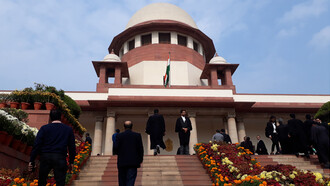The phrase “steady-state economy” has become synonymous with an environmentally sustainable planetary economic system. This entails a new economic paradigm fundamentally different from the current dominant system based on limitless growth. The World Bank, International Monetary Fund, and the World Trade Organization still use “growth in Gross Domestic Product (GDP)” as the criterion of the economic health of nations. Politicians vie for credibility with the public on the grounds that they have grown the economy or the number of jobs or raising of wages and benefits. It is all about growth.
However, as the global ecological crisis has attracted the attention of thinkers since the 1960s, economists concerned with this crisis have developed a new “steady-state” economic paradigm to replace the “endless growth” model. They show how the endless growth model is fundamentally wrong as an economic theory. Neither is it “scientific” in the least. As economist Richard Heinberg says: “Economic theory required no falsifiable hypotheses and demanded no repeatable controlled experiments.” 1 Classical economics is junk science.
As economist Kate Raworth puts this, the standard economic model (taught for the past two centuries) limits the economic equation to this formula: Starting with energy and materials, economics describes a process of “Take—Make—Use—Lose.” Economics begins with extraction and ends with waste heat and waste matter. 2 This assumes (falsely) that the resources provided by nature are essentially “free” (there for the taking). Things are manufactured from these resources (“Make”). They are sold and consumed (“Use”) and then discarded as trash (“Lose”). For classical economics, resources are not finite, nor renewable within strict limits, but are simply there to be mined, farmed, or harvested without any thought of prior limitations reflected in the economic equations for this process.
Regarding waste that is discarded, Donna Meadows, et al., describe this as a central problem of industrial civilization: “A rule of thumb says that for every ton of garbage at the consumer end of the stream has also required the production of 5 tons of waste at the manufacturing stage and 20 tons of waste at the site of initial resource extraction (mining, pumping, logging, farming).”3 This includes immense amounts of CO2 discharged into the atmosphere from the machines used to extract, transport, sell, and consume these endless products. The same is true at the “extraction” end: an aggregate human civilization based on consumption necessarily requires immense extraction beyond the carrying-capacity of the Earth.
The growth model does not consider limiting heat and material waste at the end, nor the beginning, of the process. It assumes that the endlessly “takeable” environment at the beginning is also one that can endlessly receive the poisons, wastes, and heat generated by industrial, transportation, and consumer processes. The environment has become a subset of economic theory rather than facing the real situation: economics must be a subset of our planetary ecology, that is, the environmental systems whose nature and limits make economics possible should determine its parameters.
Economist Herman E. Daly affirms that sustainable economics “begins with physical parameters (a finite world, complex ecological interrelations, the laws of thermodynamics) and inquires how the non-physical variables of technology, preferences, distribution, and lifestyles can be brought into a feasible and just equilibrium with the complex biophysical systems of which we are a part.”4 Taking into account these parameters leads to the conclusion, as Heinberg states: there is an “underlying contradiction at the heart of our entire economic system—the assumption that we can have unending growth in a finite world."5
Raworth declares: “We wasted 200 years” using this false model: “Economics, it turns out, is not a matter of discovering laws: it is essentially a question of design.” So the question is (she argues in her book as a whole): how are we to design an economy that protects human rights and human flourishing (for all of us) while at the same time carefully avoiding trespassing interdependent, planetary environmental limits? Whatever way we formulate this, it has to be “steady-state,” or, as she puts it, “agnostic about growth.”6
We are all familiar with the fact that the phrase “sustainable development” has caught on and that nearly every corporation on Earth today claims that its activities fall under this category. Yet each corporation is about growing itself, even if it recycles or “builds to last” or disposes of its toxic waste according to law. Nevertheless, these decisions by corporations are not simply arbitrary because the entire economic system of which they are part is predicated on growth and cannot function apart from endless growth. It is at this point, as human beings collectively, that we face our supreme difficulty and fundamental choice.
To embrace the paradigm shift needed to save our planetary ecology for future generations means a fundamental transformation of our ways of thinking and acting to the point where most people don’t even want to think about it. Today, as Ellen H. Brown and others have shown, 99% of all money is created as debt.7 In 1973, the U.S. threw off the gold standard in which dollars were backed by the equivalent in gold, and since that time money-creation has been primarily done through the fractional-reserve banking system.
Under this system banks (including the U.S. Federal Reserve that creates U.S. dollars) may lend to borrowers many times the number of dollars they have in reserve. Depending on national laws, reserve requirements may vary between about 3% and 10%. Hence a bank makes loans to customers by simply writing into a computer the amount of the loan and then transferring this to the customer’s account as credit. A million-dollar loan means a million dollars existing in the world that did not previously exist. It was created ex nihilo. The money was created as debt.
Debt is created on the expectation that it will be paid back with interest. Businesses worldwide borrow to grow, retool, cover rising costs, and fund startups. Without the expectation that the debt and interest will get paid back (through growth), our entire money system and its corresponding economic system would collapse. As Heinberg puts this: “growth in total outstanding debt became a precondition for the growth of the money supply and therefore for economic expansion.”8
Similarly, business growth also significantly depends on growth in consumption. Advertising promotes a culture of consumption, promoting “more is better”—the latest model is better, a larger home is better, a new car is better, more credit lines and credit cards are better, shopping is fun entertainment for your day off, and shopping malls are constructed to attract consumers exacerbating this trend. It becomes clear just how fundamental the change required will be if we want to achieve a steady-state economy, or, more graphically put, if we want to prevent our planet from becoming uninhabitable by higher forms of life.9
Daly provides a concise definition of sustainable development: “Development without growth beyond environmental carrying capacity, where development means qualitative improvement and growth means quantitative increase.”10 This definition has three main components: environmental carrying capacity, qualitative improvement, and no quantitative increase. Environmental carrying capacity refers to how many people our planetary ecosystem can support. The quantitative increase must be replaced by qualitative development: production to last, recycle, and/or repair. Extraction of resources reduced to a minimum and used to support a basic quality of life for all rather than extravagance for a few at the expense of many. Heat and material waste are reduced to an absolute minimum. Everything possible is recycled, rebuilt, and constructed for long-term use. Finally, emphasis on the quality of life rather than the quantity of income.
There is a wide consensus that we have overshot our planet’s carrying capacity in terms of the number of people it can support. “The carrying capacity is a limit,” Meadows writes, “Any population that grows past its carrying capacity, overshooting its limit, will not long sustain itself.” 11 Many economists believe we are in an “overshoot” at the present time.12 To exceed the carrying capacity of our planet does not cause immediate failure. Rather, the excessive numbers cause naturally regenerative ecosystem life supports to erode and diminish, thereby further reducing the planet’s ability to sustain its population. Eventually, there is collapse and a major die-off, with the possible extinction of the species.
Global fisheries gave been diminishing since the 1980s, global forests are disappearing (these are essential to the hydrological cycle and many other ecosystem functions), global agricultural land is shrinking, fresh water supplies are dwindling worldwide, extreme droughts are increasing, as well as extreme floods, rising ocean levels, and superstorms.13 All these are signs that we have exceeded the carrying capacity of our planet and are now, so to speak, eating up the very roots of the system that supports all life on Earth. It is very difficult to calculate the carrying capacity of the Earth with exactness because there are many variables, some of them unknown.14 Nevertheless, the dire predictions of the Intergovernmental Panel on Climate Change (IPCC) are on the mark15. A fundamental paradigm shift in our world system is mandated. Classical capitalism intertwined with militarized sovereign nation-states gives us an ecologically disastrous world system. As environmental thinker James Gustav Speth declares: “working only within the system will, in the end, not succeed when what is needed is transformative change in the system itself.”16
What is growing is the system as a whole, and the growth is not just incremental but geometrical, just as the global population is also growing in a non-linear explosion. During my lifetime it has doubled more than once, from about two billion in 1950 to 4 billion in 1974, and today at 8 billion and climbing. If the economy (or any quantity) is growing at 2% a year, it will double in 35 years. At 5% it will double in 14 years. The global economy has also been doubling during my life according to these same principles. At 2% growth per year, it will double every 35 years.
We live in what Daly calls “a full world” where there are no more vast spaces to be exploited by the economy and where our mega-waste production has nowhere to find disposal. We are simply poisoning and eating up the ecosystem that supports all life at the same time that we are producing ever more human beings to live within our planet’s rapidly diminishing ecosystem. And simultaneously we are maintaining a prodigious debt-based economic system, the indebtedness of which is simply impossible to reduce or pay back. My previous article in Meer (12 Feb. 23) has shown that the UN Sustainable Development Goals are based on these same growth principles.
Our thinking needs to be truly transformative with a magnitude that matches the existential threat we are facing. To my mind, this means ratifying the Constitution for the Federation of Earth.17 It establishes a real continuity with the present system (preserving nations, private property, democracy, etc.) at the same time that it changes the paradigm from fragmentation, atomism, and political-economic struggle to the synergy of a fundamental “unity in diversity.”
Human beings unite under a democratic constitution that protects their freedom and lists their many political and economic rights. By doing so they move from fragmentation to holism—affirming the true reality of both our humanity and our planetary ecosystem. The Earth Constitution sets up programs for a sustainable world system. It establishes a debt-free monetary system valued the same everywhere. It creates global, debt-free public banking thereby placing the global economy on a foundation that does not require endless growth.
It sets up a process of demilitarizing the world, rather than as now pouring an ever-growing waste of trillions of US dollars annually down the toilet of militarism. The Constitution declares the global commons—the oceans, major water systems, planetary rainforests, and the atmosphere we breathe—the common property of the people of Earth thereby giving the democratic World Parliament the authority to prevent their destruction by either sovereign nations or multinational corporations. The Constitution initiates voluntary programs for contraception education and family planning, thereby bringing under control the current utterly uncontrolled population explosion.
All these features are possible because the Constitution derives its authority and legitimacy from the grassroots level of humanity. It divides the planet into some 1000 World Electoral Districts that elect 1000 representatives to the House of Peoples. It involves all faculty and students in institutions of higher education worldwide in the process of selecting the 200 Counselors for the House of Counselors. And it leaves it to the nations to elect or appoint representatives to the House of Nations. Hence, a World Parliament of about 1400 to 1500 representatives will legislate laws in conformity with the protections provided by the Constitution, laws implemented by the World Administration and enforceable over all individual persons (including elected officials) by the World Courts, the World Attorney-Generals and civilian Police, and the World Ombudsmus dedicated to protecting human rights everywhere. 18
At present, the world is so locked in fragmentation that the system itself provides no way out. It is bound into militarism, into endless growth, and thereby into limitless destruction of our planetary ecosystem. Uniting humanity under the Earth Constitution gives us not only a new paradigm but a blueprint for action and transformation. It alone makes a true steady-state economy possible for our entire planet. The legitimate source of all government is the people represented, and right now the people of Earth have no one to represent them, certainly not the U.N. because it is premised on the system of sovereign nation-states. To truly represent the people of Earth is to override the endless growth imperative of capitalism and to intentionally address the population crisis. It means having entire agencies planning the integration of planetary economics for steady-state flourishing and local empowerment. It means having the World Parliament supervise planetary disarmament, taking the initiative out of the competing nation-states, and basing planetary security on a genuine peace system rather than the present war system.
The Constitution for the Federation of Earth is our escape hatch, our way out of the nightmare, a way to save humanity from extinction and establish flourishing for future generations. Sustainability means qualitative change, not quantitative increase, and the first step in qualitative change is to recognize the true unity in diversity of all the people on Earth and then go from there with a constitutional system that truly represents us all.
Notes
1 Richard, Heinberg, The End of Growth: Adapting to Our New Economic Reality. Gabriola Island, BC: New Society Publishers, 2011, p. 35.
2 Kate Raworth, Doughnut Economics: 7 Ways to Think Like a 21st Century Economist. White River Junction, VT: Chelsea Green Publishing, 2017, p. 180.
3 Donna Meadows, Jorgan Randers, and Dennis Meadows, Limits to Growth: The 30-Year Update. White River Junction, VT: Chelsea Green Publishing, 2004, p. 103.
4 Herman E. Daly, Beyond Growth: The Economics of Sustainable Development. Boston: Beacon Press, 1996, p. 4.
5 Heinberg, op. cit., p. 20.
6 Raworth, op. cit., pp. 108, 180, and Chap. 7.
7 Ellen Hodgson Brown, Web of Debt: The Shocking Truth about Our Money System. The Sleight of Hand that Has Trapped Us in Debt. Baton Rouge, LA: Third Millennium Press, 2008.
8 Heinberg, op. cit., p. 52.
9 Donald Wallace-Wells, The Coming Uninhabitable Earth: Life After Warming. New York: Penguin/Random House, 2019.
10 Daly, op. cit., p. 9.
11 Meadows, et al., op. cit. p. 137.
12 William R. Cattton, Jr., William R., Overshoot: The Ecological Basis for Revolutionary Change. Chicago: University of Illinois Press, 1982.
13 Joseph Romm, Climate Change: What Everybody Needs to Know. Oxford: Oxford University Press, 2018.
14 Joel E. Cohen, How Many People Can the Earth Support? New York: W. W. Norton & Company, 1995.
15 Wallace-Wells, op. cit.
16 James Gustav Speth, The Bridge at the Edge of the World: Capitalism, the Environment, and Crossing the Crisis to Sustainability. New Haven: Yale University Press, 2008, p. 86.
17 Constitution for the Federation of Earth, with Introduction by Glen T. Martin. Appomattox, VA: Institute for Economic Democracy Press, 2014. Found online.
18 Glen T. Martin, The Earth Constitution Solution: Design for a Living Planet. Independence, VA: Peace Pentagon Press, 2021.















